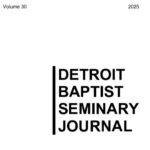Galatians and Hebrews: A Key Similarity
Ben Witherington—evangelicalism’s equivalent of the prolific Jacob Neusner—wrote a little article a while back on the influence of Galatians on Hebrews, which I’d been meaning to read in the course of my work on Hebrews. Well, just last week, I happened to be lecturing on both Galatians and Hebrews. I remembered Witherington’s piece and set aside a bit of time to see what he had to say, esp. since I’d noticed a few parallels of my own while working through both texts. Essentially, Witherington tries to explain why Hebrews shows up next to Galatians in some of the early canon lists (e.g., in the Sahidic NT). He thinks the order can be explained by the fact that the two documents share many similar features, from, e.g., rare vocabulary (e.g., πηλίκος in Gal 6:11 and Heb 7:4), to the use of similar trads. (cf. Gal 3:19 with Heb 2:2), a similar play on the ambivalence of διαθήκη (“covenant” or “will”; cf. Gal 3:15–17 with Heb 9:15–17—I think he’s wrong about Heb here), and, above all, to their similar emphasis on Jesus’ faithfulness (cf. Gal 2:16; 3:22 with, e.g. Heb 12:2—I’m not sure about the way he reads Gal here). Witherington’s conclusion—“the author of Hebrews may well have been part of the larger Pauline circle”—however, wasn’t as interesting to me as was his failure to note what I had thought was the most conspicuous similarity between the letters (though see the hint on 148): both marginalize the law-covenant with a salvation-historical hermeneutic.
So, e.g., in Galatians, Paul says law-keeping cannot be what grants “full” membership in Abraham’s family, as his opponents’ insisted, because the terms of family membership had been established nearly five centuries before the law was given and everyone knows you can’t add to the terms once they’ve been established (Gal 3:15–18). You can find Paul making a similar argument in one or two other places in the letter as well (see, e.g., Gal 3:6–9 [cf. Rom 4:10]; Gal 3:19–25; also Gal 4:1–7). Hebrews makes a similar play, arguing, e.g., that since the promise of a Melchizedekian priest (Ps 110:4) followed the establishment of the Levitical priesthood, this suggests that the Levitical priesthood was, at the least, provisional (Heb 7:11–12). After all, why talk about another priestly order if the first one was getting the job done? Hebrews makes similar arguments in a handful of other places as well, esp. in Heb 8:7–13, where the author calls attention to Jeremiah’s promise of a new covenant. New makes the other one old.
The importance of all this is that both Paul and Hebrews imply that one key difference between early Jewish and early Christian exegesis of the OT was that early Christians paid attention not simply, e.g., to the amount of revelation given a certain topic but, more fundamentally, to the location of the revelation in the Bible’s story-line. (On this point, see Carson’s piece here, esp. pp. 411–13, 27–28.)



Thanks for the post, Jared. I largely agree with your reflections. The important point, along with their common early Christian tradition rooted in the person and life of Christ, is how they treat the law-covenant with a salvation-historical hermeneutic. This, too, is arguably derived from the teachings of Jesus and the work of the Spirit. I am not completely happy with the word “marginalize,” though I get the point. I wonder if that is too negative. I think the idea is that the “law-covenant” is reframed Christologically based on a movement embedded in the OT itself. Blessing,bro.
Good point, Dan. Moreover, I think you’re dead on with your point about noting “movement embedded in the OT itself.”
You may have just won the award for most references in a 3 paragraph post. In seriousness, interesting insight. Always enjoy seeing what new thoughts you post.
Good attention to detail here. Well said.